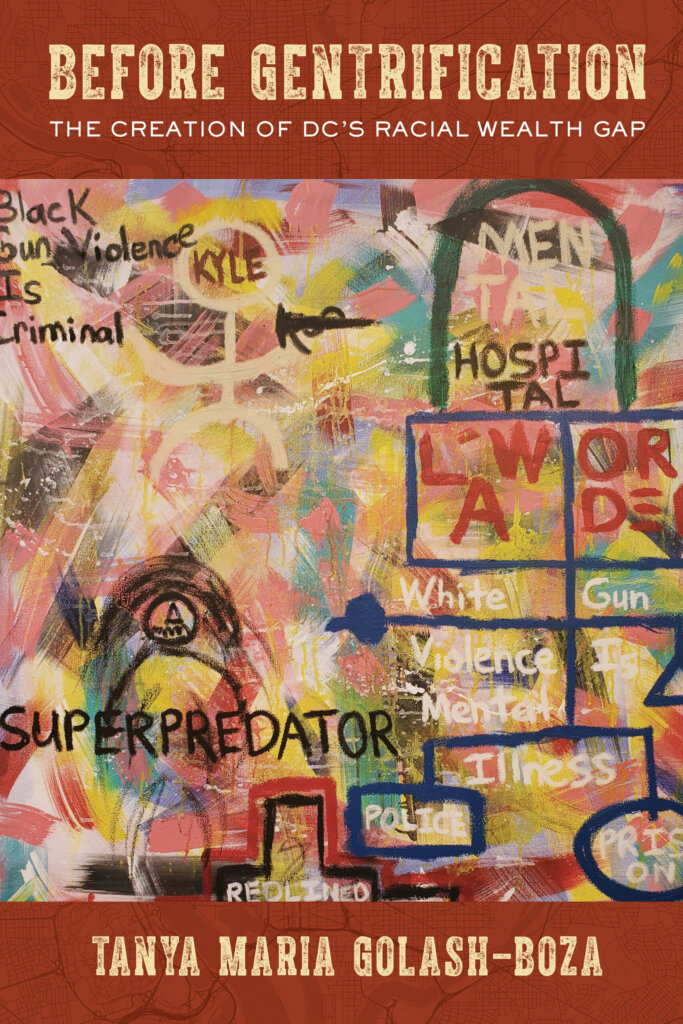By Tanya Golash-Boza, author of Before Gentrification: The Creation of DC’s Racial Wealth Gap
After enjoying a refreshing cocktail on the patio of a restaurant on 14th Street, I asked the waiter how long they had been open. He responded that they opened about a decade ago, and that they were one of the first.
This idea – that there was nothing on 14th Street before gentrifiers arrived – feels like erasure. It feels like colonization. It’s also one of the reasons I wrote my book, Before Gentrification: The Creation of DC’s Racial Wealth Gap.
I wrote this book because there’s something I want gentrifiers to know: There was something here before they came.

I want gentrifiers to know there was a lot of violence and trauma and loss here before they came. There were also girls playing double-dutch with clothesline on the corner, boys shooting hoops into milk crates nailed onto telephone poles, and kids who knew they needed to be home when the streetlights came on.
I can see why gentrifiers like my neighborhood, with its brick houses and tree-lined streets and its proximity to Rock Creek Park. But, gentrifiers can’t see what I see when I walk down Kennedy Street. When I walk down those streets, I see pain and joy and loss.
My parents, my brother Ian, and I moved from to 4th and Kennedy Streets NW in 1976, when I was two years old. My parents are White. They also are activists and chose to move into a Black neighborhood in a segregated city because they wanted to raise anti-racist children. One of my earliest memories is of going to a May Day March with my father and chanting: “Asian, Latin, Black, and White: Workers of the World Unite” as we marched down 16th Street towards the White House.
When I walk down Kennedy Street, I remember getting wings with mumbo sauce from the carryout. I remember jumping down to lie flat to avoid gunshots. I remember attending Erika’s funeral. I remember Maurice, Earl, Juice, Alo, and others whose lives were cut short by gunshots. I remember Gerald and Stink who are still behind bars, and so many others who lost decades of their lives to incarceration.
I remember Trina dropping money out of her second-floor apartment so I could buy her a hot mama sausage from the corner store. I’d throw it up to her window in a paper bag with her change. Her mother didn’t allow her to leave the house after she got home from school.
I remember Rare Essence played live go-go music every Wednesday at the Ibex. Niki and I always dressed to impress, with brand new high top white Reeboks and matching outfits. One thing you should know about DC girls: We were fly.
It’s fascinating, isn’t it? Our friends were being killed and sent away to prison. Our friend’s mothers were on crack. But we always looked good. We wore earrings made of real gold, carried designer purses, and always had a fresh outfit and hairdo to go to the go-go, even though we would surely sweat it right out by the night’s end.
I know gentrifiers can’t see any of this. I know they have no idea because they were not here. I never saw any White people other than my family members on or around Kennedy Street.
Back then, White folks did not come to my side of town. Today, White folks feel comfortable walking their dogs down Kennedy Street, any time of day or night.
But, gentrifiers’ experiences of walking down Kennedy Street are not the same as mine or of other long-term residents. Sure, we like the fact that it’s safer. We like the new restaurants, bars, cafes, and coffee shops. I am not mad that the corner store now has Sauvignon Blanc from New Zealand and San Pellegrino sparkling water. But, I also can see what’s been lost.
Imagine walking down the street where your family once lived, where everything reminds you of the lives lost to gun violence, to drug addiction, and to prison.
Imagine people moving in and claiming to be the first, because they think there was nothing worth seeing here before they arrived.
We can’t bring back the 4,000 lives lost to gun violence in DC from 1985 to 1995. We can’t give back the decades so many residents lost behind bars. But we also can’t move forward without a reckoning with what happened.
The devastation wreaked on Black communities in the 1980s and 1990s made gentrification possible and profitable. We can’t erase this devastation, but we must reckon with it. And, we can’t do that through erasure.
This post is part of our #ASA2023 blog series. Visit our virtual ASA 2023 website and find out how to get 40% off our books.
